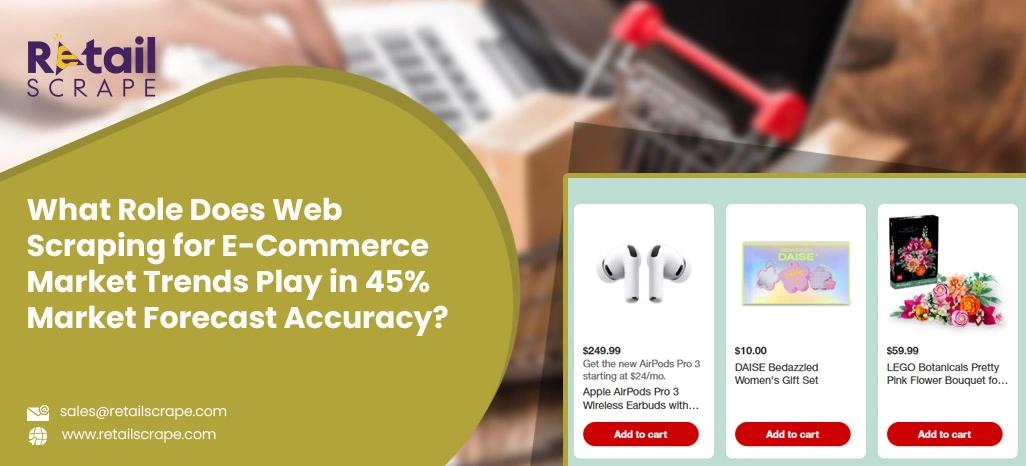What Role Does Web Scraping for E-Commerce Market Trends Play in 45% Market Forecast Accuracy?

Introduction
The e-commerce ecosystem is continuously evolving, driven by shifting consumer habits, new digital platforms, and rapidly emerging global competitors. In this ever-changing landscape, understanding real-time buying behaviors and price fluctuations has become critical to maintaining profitability. That’s where Web Scraping for E-Commerce Market Trends plays an essential role, providing businesses with accurate, timely, and structured data to interpret and act upon market movements effectively.
Today’s digital-first companies depend heavily on data analytics to predict consumer demand, identify growth opportunities, and make informed product decisions. By integrating E-Commerce Data Intelligence, retailers can transform raw data into meaningful insights that enhance forecasting accuracy. Whether it's identifying underperforming SKUs or tracking rising product categories, web scraping helps organizations refine their strategies through precision data-driven insights.
As competition intensifies across platforms, adopting this technology ensures businesses are equipped to anticipate demand shifts, adapt pricing strategies, and align marketing efforts with evolving preferences. This foundation of data-backed intelligence leads to better predictions, improved customer satisfaction, and sustainable growth across the global e-commerce marketplace.
Advancing Data Accuracy Through Predictive Evaluation

Consumer preferences shift rapidly across categories, influenced by trends, pricing, and promotions. To address this, businesses are increasingly relying on structured data extraction and automation. Implementing advanced E-Commerce Data Scraping Tools allows brands to gather and analyze large volumes of real-time marketplace information such as product listings, customer reviews, and pricing adjustments.
By analyzing this collected information, companies can assess purchasing habits and seasonal demand cycles, enhancing prediction accuracy significantly. The value lies in the ability to not only access but also interpret millions of data points instantly. The integration of these tools supports decision-makers in product stocking, dynamic merchandising, and targeted marketing, leading to better synchronization between production and actual market demand.
Furthermore, the ability to monitor trends across multiple geographies enhances Online Retail Trend Analysis, ensuring businesses can respond quickly to changing regional demands. Organizations adopting such data-driven strategies have seen up to a 45% improvement in forecasting precision compared to traditional methods. This refined approach minimizes waste, improves supply chain efficiency, and strengthens customer satisfaction by ensuring product availability aligns with current buying behavior.
| Market Data Aspect | Collected Insight Type | Business Benefit |
|---|---|---|
| Product Demand Metrics | Reviews and purchase frequencies | Smarter stock management |
| Competitor Pricing Data | Comparative price patterns | Enhanced forecast accuracy |
| Seasonal Market Behavior | Recurring category trends | Efficient marketing planning |
Leveraging E-Commerce Market Monitoring processes supported by advanced scraping technology helps retailers maintain responsiveness in volatile markets. Businesses using these insights can dynamically adjust stock levels, reduce excess inventory, and maintain consistency between forecasted and actual sales outcomes.
Gaining Strategic Clarity Through Market-Wide Visibility

Competing effectively in digital commerce requires deep insight into product movements, pricing strategies, and customer behavior. By adopting comprehensive data collection frameworks powered by Global E-Commerce Data Scraping APIs, businesses gain unrestricted access to vital performance metrics across multiple online marketplaces.
Retailers leveraging these systems can monitor performance variations across categories, track best-selling products, and detect early changes in consumer sentiment. This approach supports Competitive Pricing and Product Tracking, where companies can evaluate their pricing elasticity and promotional effectiveness in comparison to industry benchmarks. As a result, it becomes easier to identify opportunities for optimization in both pricing and assortment planning.
By using regional datasets, organizations can uncover localized consumer patterns that influence purchasing decisions, contributing to more effective marketing personalization. The inclusion of advanced analytics also assists in identifying which categories require inventory adjustments, promotional changes, or enhanced ad placement. This helps maintain a consistent growth curve while minimizing missed opportunities.
| Analytical Area | Data Collected | Operational Impact |
|---|---|---|
| Competitor Benchmarking | Performance metrics and reviews | Refined campaign strategies |
| Regional Pricing Variations | Localized rate comparisons | Better margin control |
| Product Lifecycle Analysis | Launch-to-obsolescence tracking | Enhanced demand accuracy |
Integrating these insights provides substantial advantages in Retail Data Scraping Solutions, enabling brands to respond faster to price fluctuations and competitor movements. The resulting visibility fosters stronger brand agility, supports cross-border market expansion, and refines decision-making processes to ensure sustained profitability.
Building Predictive Strength Through Data-Driven Insights

The transformation of unstructured marketplace data into actionable insights is what differentiates high-performing retailers from the rest. By implementing adaptive analytical frameworks and Dynamic Pricing Solutions, businesses can model pricing elasticity, assess competitor moves, and simulate possible market outcomes. These solutions allow instant price optimization and enable companies to balance profitability with customer value perception.
Moreover, the introduction of predictive algorithms enhances the effectiveness of Brand Performance Analytics, where sales trends, campaign performance, and consumer engagement metrics are analyzed collectively. These analytics reveal patterns in customer preferences and product success rates, offering early signals for future category investments.
In addition, Real-Time E-Commerce Insights offer unparalleled transparency into how pricing adjustments, stock availability, and promotional efforts impact customer response. Retailers can visualize demand surges, identify underperforming SKUs, and make informed operational changes almost instantly. This proactive monitoring facilitates smarter marketing, improved inventory accuracy, and greater conversion stability.
| Analytical Segment | Insight Derived | Resulting Impact |
|---|---|---|
| Customer Purchase Behavior | Trend forecasting accuracy | Enhanced loyalty outcomes |
| Competitor Launches | Early detection and benchmarking | Stronger product strategy |
| Inventory Balance | Overstock and shortage prevention | Cost and margin improvement |
When these data intelligence systems work cohesively, they offer businesses the foresight to anticipate consumer demand and optimize their long-term strategies. The combination of analytics-driven pricing, demand anticipation, and ongoing optimization builds sustainable competitive resilience in an ever-changing digital marketplace.
How Retail Scrape Can Help You?
Our solutions empower businesses through the application of Web Scraping for E-Commerce Market Trends, helping them capture actionable insights from multiple data sources efficiently. We specialize in transforming raw market information into structured datasets that support faster, smarter business decisions.
Our team provides scalable data extraction solutions customized for retailers, manufacturers, and e-commerce analytics firms. With advanced automation, we help you simplify data monitoring, trend detection, and competitive strategy formulation through:
- Real-time collection of marketplace and product data.
- Customized dashboards for easy analytics integration.
- Tracking of regional and seasonal product trends.
- Automated pricing intelligence feeds.
- Consumer review and sentiment analysis.
- Competitor performance benchmarking.
Our services also enhance E-Commerce Market Monitoring, giving you the visibility needed to refine operations and maintain an edge in the fast-moving retail ecosystem.
Conclusion
Adopting Web Scraping for E-Commerce Market Trends empowers brands to make data-driven decisions that strengthen forecasting, pricing, and marketing strategies. As global markets evolve, businesses relying on traditional data models risk missing critical opportunities, while data-backed organizations achieve consistent accuracy and growth.
By implementing Brand Performance Analytics, companies can translate raw market information into long-term competitive advantages. Ready to reshape your retail intelligence strategy? Contact Retail Scrape today to turn your e-commerce data into real-world success.


